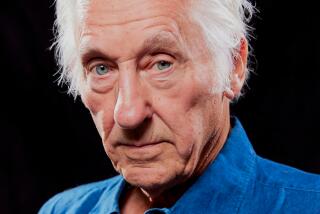Review:: Natural landscapes turned noxious in photography on view at Blum & Poe
- Share via
A toxic beauty emanates from — or maybe infects — six impressive new landscape photographs and three abstractions by Florian Maier-Aichen.
It’s the sixth solo show at Blum & Poe by the German-born, L.A.-based artist, and it represents a milieu in which he has worked for more than a dozen years. Despite all its colorful (and technical) dazzle, however, it is marked by a sometimes searing, often distinctly bleak tone.
Waterfalls, the seashore, sunsets — buoyant romantic clichés are infused with an otherworldly intensity, as rainbows of color cascade down a Yosemite cliff, slide across the surface of the Pacific Ocean and lap along the seashore riding the edges of waves. Liquidity, whether water or airy space, is heightened by the evident tinkering with fluid chemicals used to print photographs.
Inspirations come from familiar pictures, ranging from bland, mass-produced cards by Hallmark and American Greetings to singular works from the 19th and early 20th centuries by photographers Carleton Watkins, Gustave Le Gray and Anne W. Brigman. Once invoked, the chestnuts get abruptly turned upside down.
The bracing rapids of a mountain stream are edged in purple, green and pink, colors that also turn up as tiny flecks dotting the ecologically compromised foliage on the adjacent mountainside. Water from the misty spray of another waterfall got onto Maier-Aichen’s film as it was being exposed, so the photographic subject participated in making a blotchy image that appears at once animated and sickly.
In another, a blood-red tide slides down hillsides and into the ocean, where it floats out beyond the shoreline. The scene is framed by a silhouetted tree branch, its leaves seeming to drip blood. Other spiky, totally barren branches probe a small red island and poke into the hillside, like a mosquito piercing the skin of a host to extract sustenance.
Elsewhere, the full color spectrum is teased out of blasting white light, thanks to an old-fashioned, prismlike tricolor filming process. As the pictured sun sinks slowly in the West, a strip of the sea erupts into a glorious rainbow or a festering gash, and the horizon lights up like a nuclear flash.
A narrative of climate change segues into climate crisis, right before your eyes. Maier-Aichen’s seascape reveals itself to be both natural and metaphoric — profoundly so, given today’s slumping political environment.
Subtle tensions between corruption and grace arise in Maier-Aichen’s photographs, reflecting the long-standing hybrid nature of his work. Ours is a transitional and destabilizing era, with one foot planted in a world long dominated by lens-based ways of seeing and the other in a rapidly expanding digital sphere. That this new body of work homes in on buffeted landscapes lends an urgent topicality to the shrewdness of his artistic enterprise.
Maier-Aichen prints his photographs at the scale of paintings — he shoots with a large-format camera — in dimensions commonly reaching 5, 6, even 7 feet. (Two smaller “chemigrams,” camera-less pictures made by pouring chemicals on light-sensitive paper, plus one bigger, fractured Photoshop abstraction further the painterly references.) Their size emphasizes that the artist is making photographs, not only taking them.
Blum & Poe, 2727 La Cienega Blvd., Culver City. Tuesdays-Saturdays, through July 6. (310) 836-2062, blumandpoe.com
More to Read
The biggest entertainment stories
Get our big stories about Hollywood, film, television, music, arts, culture and more right in your inbox as soon as they publish.
You may occasionally receive promotional content from the Los Angeles Times.











